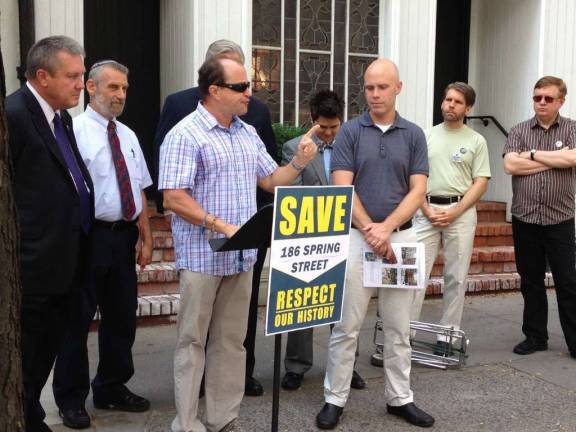LGBTQ History Becomes Focus of Saving 186 Spring Street Federal Style House

By Alissa Fleck When the Greenwich Village Society for Historic Preservation (GVSHP) first discovered that developer Stephan Boivin intended to raze the 1824 federal style house formerly belonging to Beastie Boy Adam Horovitz, the group focused primarily on the house's architectural merit. Boivin's development group, Nordica, hoped to transform the house into apartments and retail space. The Landmarks Preservation Commission (LPC) responded to community advocates in favor of the building's preservation by saying the house does not qualify as a landmark because it does not retain enough of its original material, though its general area in the neighborhood is still under consideration. After this obstacle and further research, the GVSHP began to focus instead on the house's rich history and ties to the LGBTQ community. As the group explained, the City has never before declared something a landmark based on the history of the gay and lesbian movement. At a press conference outside the Spring Street house today, elected officials and community advocates came together to speak to this colorful history. Senator Tom Duane, the second openly gay member of the New York State legislature, appeared at the conference to make a statement, and Council Speaker Christine Quinn sent a letter in support. Steve Ashkinazy, Stonewall Democratic Club executive committee member, said early leaders of the Gay Activists Alliance (GAA) formerly resided in the South Village home. The GAA group was the blueprint for the LGBT movement, he explained. "Now they want to turn it into a mall," said Ashkinazy. "The City says it does not retain enough of its original character...it's clearly older than its surroundings. It's visually and architecturally a standout with a story to tell." "The world has changed here and New York needs this landmark," he added. GVSHP Executive Director Andrew Berman said, of former residents with ties to the gay rights movement: "People who lived here touched others' lives." He added, as an openly gay man who has worked under Senator Duane and is well-versed in the region and the struggles of civil rights groups, even "for [him], this house was a lesson." Laurence Frommer, a licensed NYC tour guide, said he, and others, have been reaching out to queer historians, hoping to bring the matter to national attention. While the midday turnout was a relatively small spattering, Frommer said he had been hoping for "a cast of thousands." "As somebody interested in chronicling and presenting LGBT history, this is important," said Frommer. "It should be landmarked. There should be a plaque." "There's so much in the City we don't know about," said Frommer. "How did it get lost?" As for the civil rights angle, Frommer said he believes the City is trying presently to make up for a lack of African American historical representation, but they should be focusing on LGBTQ history also, and every other group as well. He said the City usually preserves landmarks based on architectural merit and less so cultural matters or history, but culture should be "considered a lot more."